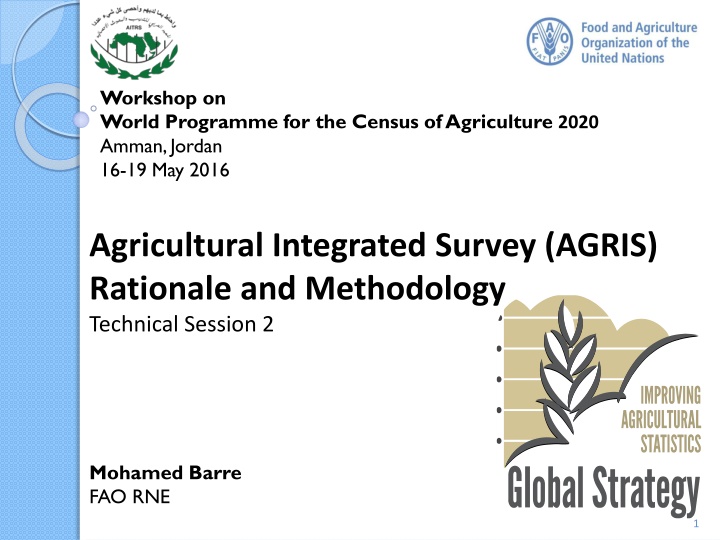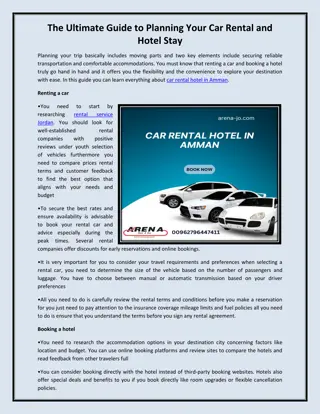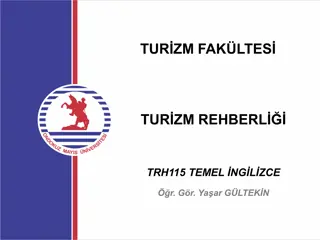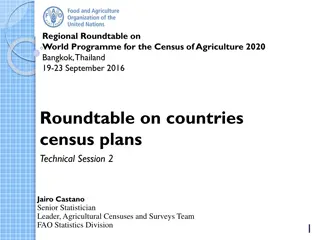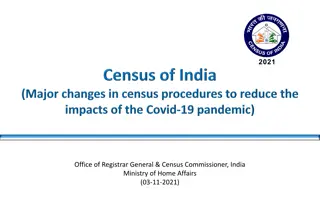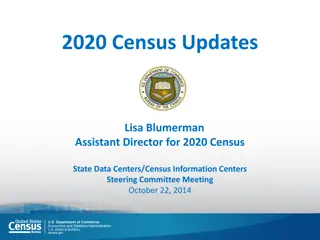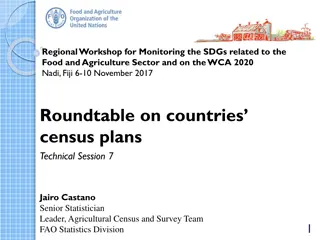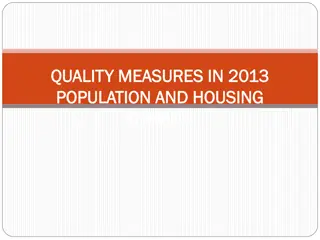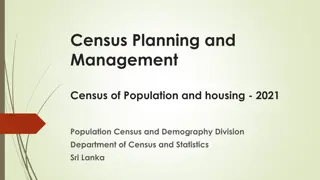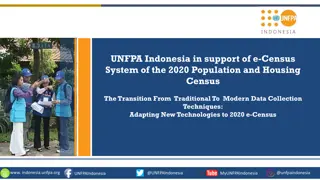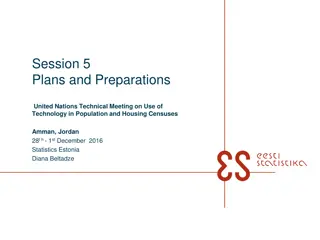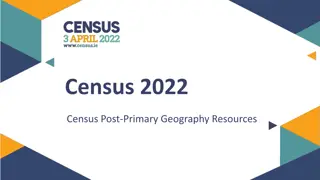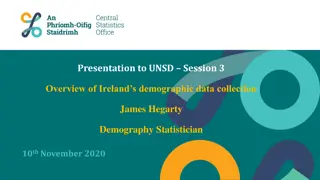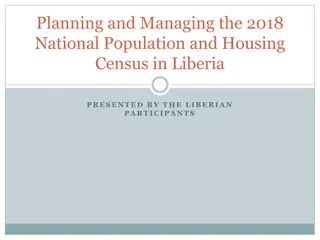Workshop on World Programme for the Census of Agriculture 2020 in Amman, Jordan
The workshop in Amman, Jordan discussed the importance of the Agricultural Integrated Survey (AGRIS), focusing on its rationale, methodology, toolkit development, and implementation. AGRIS aims to enhance the collection of statistical data on the agricultural sector globally, supporting policy-making, market efficiency, and research. The survey operates over a 10-year cycle, collecting data on agricultural production, socio-economic statistics, and various thematic areas. It also emphasizes the collection of sex-disaggregated data to assess gender roles in agriculture.
Download Presentation

Please find below an Image/Link to download the presentation.
The content on the website is provided AS IS for your information and personal use only. It may not be sold, licensed, or shared on other websites without obtaining consent from the author.If you encounter any issues during the download, it is possible that the publisher has removed the file from their server.
You are allowed to download the files provided on this website for personal or commercial use, subject to the condition that they are used lawfully. All files are the property of their respective owners.
The content on the website is provided AS IS for your information and personal use only. It may not be sold, licensed, or shared on other websites without obtaining consent from the author.
E N D
Presentation Transcript
Workshop on World Programme for the Census of Agriculture 2020 Amman, Jordan 16-19 May 2016 Agricultural Integrated Survey (AGRIS) Rationale and Methodology Technical Session 2 Mohamed Barre FAO RNE 1
Outline 1. Rationale 2. Methodology 3. Toolkit development 4. Implementation 2
1. Rationale Need for more, better, cheaper and faster statistical data on the agricultural and rural sector, farm level Data collection still weak in many countries 3
1. Rationale Global Strategy Minimum Set of Core Data : AGRIS collects 65% of the MSCD ; large contribution to SDGs monitoring AGRIS data will inform policy design and implementation, improve market efficiency and support research AGRIS, being a 10-year integrated survey program, lays the foundations for the creation of an efficient agricultural statistical system. It complements theAgricultural Census. 4
2. Methodology Modular Structure Synchronized with the Agricultural Census and operates over a 10-year cycle. Core Module: yearly data collection on current agricultural production (crop and livestock) integrated with economic and socio-demographic statistics (roster) Rotating Modules : thematic data to be collected with lower frequency (2-5 years): economy, labor, machinery & equipment, production methods & environment. Statistical Units All agricultural holdings household sector non-household sector Sample design Versatile sampling strategy, able to meet the different country situations. Multiple waves for data collection recommended (labour, economy, core (?)) Data collection process Face-to-face interviews Rely on Global Strategy data collection methods including GPS, CAPI, etc. 5
2. Methodology Proposed data collection set-up Years 0 1 2 3 4 5 6 7 8 9 10 Agricultural Census AH Roster AGRIS Module Core Crop production Livestock production AGRIS Rot. Module 1 Economy AGRIS Rot. Module 2 Labour force AGRIS Rot. Module 3 Machinery and equipment AGRIS Rot. Module 4 Production methods and environment 6
2. Methodology Topics covered and data items AGRIS complements the census of agriculture AGRIS covers technical, economic, environmental and social dimensions of agricultural holdings (Toolkit: generic questionnaires) AGRIS collects sex-disaggregated data on key topics: to identify male / female headed holdings to assess women's contribution to agriculture: labour access to and control of productive assets, resources and services 7
2. Methodology: core module AH ROSTER PRODUCTIONS, FOR ALL CROPS OF INTEREST 1. Last agricultural campaign PRODUCTIONS, FOR ALL LIVESTOCK OF INTEREST 4. Livestock in the AH at the date of survey 0.1. Household Ag. Holding Roster 1.1. Area sowed 0.1.1. Household Information Panel (incl. GPS coord) 4.1. Present heads 1.2. Area harvested 0.1.2. Household Characteristics 4.2. Nb of births 1.3. Irrigated area 0.1.3 List of Household Members 0.1.4. Education 4.3. Nb of animals bought 4.4. Nb of animals sold 4.5. Nb of animals slaughtered in the farm 4.6. Nb of animals delivered to the slaught. house 4.7. Nb of animals dead and stolen 1.4. Area in organic farming 1.5. Quantity in storage at the beginning of harvest 1.6. Production harvested 0.1.5. Child Labour 0.1.6. Gender 1.7. Use of fertilizers, pesticides, herbicides 0.1.7. Social Protection 0.2. Non-household Ag. Holding Roster 0.2.1. Holding Information Panel (incl. GPS coord) 0.2.2. Holding Characteristics 1.8. Use of other inputs 4.8. Price per Kg of products sold 1.9. Price per Kg of products sold 4.9. Total carcass weight of slaughtered animals 5. Production of row milk 6. Production of eggs 7. Other animal productions 8. Production shocks 1.10. Share used for food processing 1.11 Share used for other self-consumption 2. Next campaign 2.1 Area foreseen 3. Production shocks 8
2. Methodology: rot. modules ROTATING MODULE 1: ECONOMY (QUANTITIES, TYPES AND AMOUNTS) 1. Means of production (no labour) 1.1 Land tenure 1.2 Property of livestock 1.3 Storage capacity 2. Income 2.1 Total income 2.2 Income from agricultural activities 2.3 Income from other gainful activities 2.4 Subsidies/aid received 3. Costs of production 3.1 Linked to crop production 3.2 Linked to livestock production 3.3 Salaries 3.4 Insurance 3.5 Linked to other gainful activities 4. Main commercial networks for the production 5. Credit and access to financing 6. Access to information and other issues 9
2. Methodology: rot. modules ROTATING MODULE 2 : LABOUR FORCE 1. Household members contribution to the agricultural holding (HH sector only) 1.1. Basic demographics information 1.2. Participation in agricultural activities of the AH (incl. salary/wages; employment/own use production, etc.) 1.3. Participation in diversification activities of the AH (incl. salary/wages; employment/own use production, etc.) 1.4. Participation in other activities (incl. unpaid domestic activities, care, other activities related to own family AH) 1.5. Managerial role in the agricultural activities on the AH 2. Household members other working activities - diversification (HH sector only) 3. Hired labour of the AH (HH and non HH sectors) 3.1. Basic demographic information 3.2. Participation in agricultural activities (incl. salary/wages) 3.3. Participation in diversification activities of the AH (incl. salary/wages) 3.4. Wages / labour cost 3.5. Work conditions (incl. decent work, informality, etc.) 4. Other labour force used in the AH (HH and non HH sectors) 4.1. Non-permanent employees (seasonal) 4.2. Agricultural work carried out by a specialised company 4.3. Other labour force 10
2. Methodology: rot. modules ROTATING MODULE 3 : MACHINERY AND EQUIPMENT (TYPES & QUANTITIES IN USE, ACCESS & OWNERSHIP) 1. Manually operated equipment 2. Animal powered equipment 3. Machines for general farm use 4. Tractors, bulldozers and other vehicles 5. Land preparation and planting machinery and equipment 6. Crop maintenance machinery and equipment 7. Crop harvesting machinery and equipment 8. Post-harvest machinery and equipment 9. Livestock machinery and equipment 10. Aquaculture machinery and equipment 11. Energy production machinery and equipment 12. Storage and marketing machinery and equipment 13. Water management machinery and equipment 11
2. Methodology: rot. modules ROTATING MODULE 4 : PRODUCTION METHODS AND ENVIRONMENT (QUANTITIES, TYPES AND AREAS) 1.Crops production systems and resources 1.1 Fertilizers 1.2 Pesticides/herbicides 1.3 Crops and seeds varieties and resources 1.4 Crop rotation 2.Livestock production systems and resources 2.1 Livestock varieties and resources 2.2 Animal housing, manure management 2.3 Veterinary products 2.4 Feed and use of pastures 3. Soil management 4. Irrigation and drainage 5. Agro forestry 6. Access to and use of services, infrastructure and natural resources 6.1. Agricultural extension services (incl. veterinary) 6.2. Infrastructure (incl. IT, communications, roads) 6.3. Access to natural and common property resources 7. Greenhouse gas 8. Adaptation to climate change and mitigation strategies 12
2. Methodology Data access: in-line with national policies and central catalog with FAO AGRIS toolkit: methodological resources, guidelines and software/code: Planning and design Data collection Data processing, analysis, archiving Data dissemination 13
3. Toolkit development Strategy for the toolkit development Lead : GS / FAO + specialized expertise contracted out what first (questionnaires), how second priority (sampling) Rotating modules first (long versions, then short versions), then core module Generic questionnaires Different versions for different farming systems (core, PM?) Different versions for different data collection schemes = nb waves (rotating modules) Multilingual 14
3. Toolkit development Questionnaires development Process Identify data needs : engage with data users Review existing survey practices: Good and bad: inventory and analysis of relevant existing surveys International standards and guidelines List data items and develop questions, classifications and modules Status Labor, Eco, PM, M&E - Core Module : draft in April, final in June Limited field tests in April-June + flow & sampling: April June, based on MSF and other existing materials 15
4. Implementation National implementation and alignment with national priorities : NSDS SPARS Customization of generic questionnaires + flows, sampling, etc. Implementation at country level starting in 2016 (GS / USAID). Arrangements at global level (being finalized): Research, methodological refinements, international coordination (GRAInS partnership: linkages with WB-LSMS, USAID/USDA, IFAD, ) Training, TA, and funding opportunities Toolkit available for everyone to get free inspiration for free implementation 16
